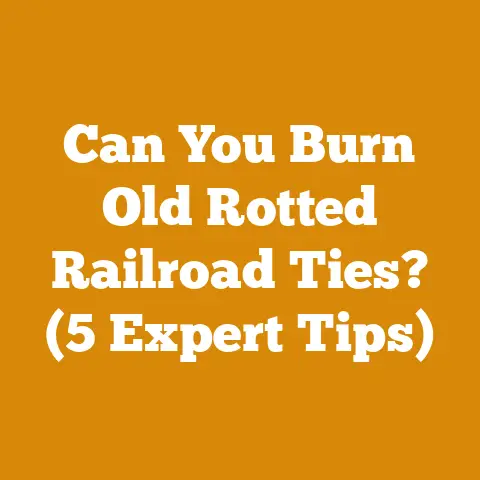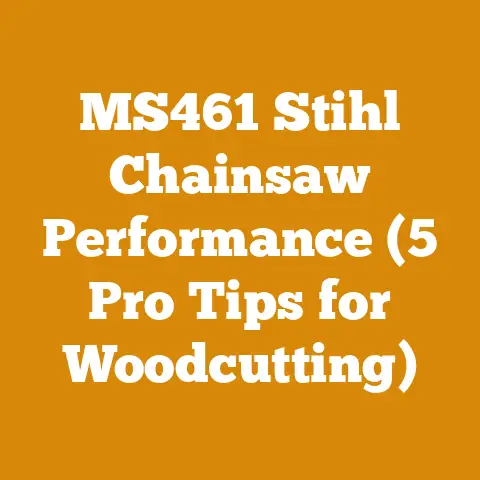Chainsaw for Bushes: Expert Tips for Precise Cuts (7 Pro Tricks)
Okay, here we go.
Let’s dive into the surprisingly delicate world of using a chainsaw for…bushes.
Because who needs pruners when you’ve got a roaring, gas-powered beast at your disposal, right?
(Don’t answer that.
It’s rhetorical… mostly.)
Chainsaw for Bushes: Expert Tips for Precise Cuts (7 Pro Tricks)
I’ve seen it all in my years of wood processing, from felling towering oaks to delicately shaping bonsai trees (okay, maybe not that delicately).
But the idea of using a chainsaw on bushes often conjures images of…well, a massacre.
However, with the right techniques and a healthy dose of respect for the tool, you can achieve surprisingly clean and precise cuts.
Key Takeaways You’ll Learn:
- Understanding when (and when not) to use a chainsaw on bushes.
- Choosing the right chainsaw and safety gear.
- Mastering essential cutting techniques for controlled shaping.
- Avoiding common mistakes that lead to bush carnage.
- Maintaining your chainsaw for optimal performance.
- Exploring alternatives if a chainsaw is truly overkill.
- Sharpening your chainsaw skills for precision work.
A Chainsaw and a Bush? My First Encounter
I remember my first encounter using a chainsaw near a bush.
I was helping a friend clear out some overgrown landscaping.
He handed me a beast of a chainsaw, a Stihl MS 271 Farm Boss, and pointed towards a rhododendron that had seen better days.
“Just trim it back a bit,” he said casually.
Now, I’m no stranger to chainsaws.
I’ve felled trees that could house a family of squirrels.
But a bush?
It felt…wrong.
My initial attempts were, let’s just say, less than elegant.
I ended up with a lopsided, butchered rhododendron that looked like it had lost a fight with a wood chipper.
It was a humbling experience, to say the least.
But it sparked a determination to learn how to use a chainsaw with finesse, even on something as seemingly insignificant as a bush.
The Allure (and the Danger) of Chainsaws on Bushes
Why even consider using a chainsaw on bushes?
Here’s the thing: Sometimes, traditional pruning shears just won’t cut it (pun intended!).
Overgrown, woody shrubs with thick branches can be a real pain to manage with hand tools.
A chainsaw, with its power and speed, can make quick work of these tough jobs.
However, the allure of a chainsaw on a bush is often outweighed by the potential for disaster.
Chainsaws are inherently dangerous tools, and using them in close quarters, around delicate plants, requires a high level of skill and caution.
According to a study by the Consumer Product Safety Commission, chainsaws cause over 30,000 injuries each year in the United States alone.
Many of these injuries occur during routine tasks like tree trimming and brush clearing.
The Irony? We use a tool designed to fell massive trees to trim something delicate.
It’s like using a sledgehammer to crack a nut.
It can be done, but you’d better know what you’re doing.
When to Unleash the Chainsaw (and When to Back Away Slowly)
Before you even think about firing up your chainsaw, ask yourself: Is this really the best tool for the job?
Good Candidates for Chainsaw Pruning:
- Overgrown, woody shrubs: Plants like overgrown rhododendrons, forsythia, or lilacs with branches thicker than 2 inches.
- Large-scale clearing: Removing multiple shrubs or thickets quickly.
- Dead or diseased branches: Chainsaws can efficiently remove large, infected branches that are difficult to cut with hand tools.
Situations Where a Chainsaw is a No-Go:
- Delicate pruning: Shaping small, ornamental shrubs or plants with thin branches.
- Close proximity to structures: Working near fences, buildings, or power lines.
- Unstable footing: Pruning on ladders or uneven terrain.
- Lack of experience: If you’re not comfortable using a chainsaw, stick to hand tools.
Expert Insight: “The key to successful chainsaw pruning is to use it only when necessary,” says arborist Mark Johnson.
“Don’t reach for the chainsaw just because it’s faster.
Consider the health of the plant and the precision required.”
Gear Up: Chainsaw Safety 101 (Because Limbs Are Important)
Safety is paramount when using a chainsaw, especially when working in close quarters.
Here’s a checklist of essential safety gear:
- Chainsaw chaps: These protect your legs from accidental cuts.
I’ve seen too many close calls to ever skip this step. - Eye protection: Safety glasses or a face shield are crucial to protect your eyes from flying debris.
- Hearing protection: Chainsaws are loud! Earplugs or earmuffs will prevent hearing damage.
- Gloves: Sturdy work gloves provide a better grip and protect your hands from splinters and cuts.
- Helmet: A helmet with a face shield offers the best protection for your head and face.
- Steel-toed boots: Protect your feet from dropped branches and accidental chainsaw contact.
Personal Story: I once saw a colleague, a seasoned logger, get complacent and skip the chaps while clearing some brush.
A moment later, his chainsaw kicked back, and he ended up with a nasty gash on his leg.
Luckily, it wasn’t worse, but it was a stark reminder that even experienced professionals need to prioritize safety.
Choosing the Right Chainsaw: Size Matters (and So Does Weight)
Not all chainsaws are created equal.
For pruning bushes, you’ll want a smaller, lighter model that’s easy to maneuver.
- Electric chainsaws: These are a good option for smaller jobs and are quieter and easier to start than gas-powered models.
They are also lighter, making them easier to control. - Gas-powered chainsaws: For thicker branches and larger jobs, a gas-powered chainsaw may be necessary.
Choose a model with a shorter bar (12-14 inches) for better control. - Pole saws: These are ideal for reaching high branches without using a ladder.
However, they can be more difficult to control.
Data Point: According to a survey by Popular Mechanics, the average homeowner uses a chainsaw for less than 20 hours per year.
For occasional bush pruning, an electric chainsaw may be a more practical choice than a gas-powered model.
Pro Tip: Consider the weight of the chainsaw.
A heavier chainsaw will be more tiring to use, especially when working overhead.
Master the Art of the Precise Cut: Techniques for Bush Pruning
Now for the fun part: actually using the chainsaw on your bushes.
Here are some techniques to help you achieve clean, precise cuts:
Plan Your Cuts: Before you start cutting, take a step back and assess the overall shape of the bush.
Identify the branches you want to remove and plan your cuts accordingly.Use the Right Cutting Angle: For clean cuts, angle the chainsaw slightly downward.
This will help prevent the branch from tearing as it falls.Make Relief Cuts: For thicker branches, make a relief cut on the underside of the branch before making the final cut from the top.
This will prevent the bark from tearing and damaging the plant.Control the Chainsaw: Use a firm grip and keep the chainsaw close to your body for better control.
Avoid reaching or overextending.Let the Chainsaw Do the Work: Don’t force the chainsaw through the branch.
Let the chain do the cutting, and maintain a steady, even pressure.Avoid Kickback: Kickback is a dangerous phenomenon that occurs when the tip of the chainsaw bar comes into contact with an object.
To avoid kickback, always be aware of the position of the chainsaw bar and avoid cutting with the tip.Practice Makes Perfect: Don’t be afraid to practice on scrap wood before tackling your bushes.
This will help you get a feel for the chainsaw and develop your cutting technique.
Step-by-Step Example: Pruning an Overgrown Rhododendron
- Assess the plant: Identify dead, diseased, or crossing branches.
- Clear the area: Remove any obstacles around the bush.
- Gear up: Put on all necessary safety gear.
- Start with smaller branches: Use pruning shears to remove thin branches and twigs.
- Make relief cuts: For thicker branches, make a relief cut on the underside.
- Make the final cut: Position the chainsaw slightly downward and make a clean cut from the top.
- Clean up: Remove any debris and dispose of branches properly.
Common Mistakes to Avoid: Don’t Be That Guy (or Gal)
Using a chainsaw on bushes can be tricky, and it’s easy to make mistakes.
Here are some common pitfalls to avoid:
- Over-pruning: Removing too much foliage can weaken the plant and make it susceptible to disease.
- Leaving stubs: Cutting branches too far from the main stem can create unsightly stubs that are prone to rot.
- Tearing bark: Using a dull chain or cutting at the wrong angle can tear the bark and damage the plant.
- Ignoring safety: Failing to wear proper safety gear or using the chainsaw improperly can lead to serious injury.
- Cutting too fast: Rushing the job can lead to mistakes and accidents.
Take your time and focus on making clean, precise cuts.
Expert Quote: “The biggest mistake I see people make is trying to do too much too quickly,” says landscape designer Sarah Miller.
“Pruning should be a gradual process, not a one-time event.”
Chainsaw Maintenance: Keep Your Beast Running Smoothly
A well-maintained chainsaw is a safer and more efficient chainsaw.
Here are some essential maintenance tasks:
- Sharpen the chain: A dull chain is more likely to kick back and can also tear the bark.
Sharpen the chain regularly using a chainsaw file or a chain sharpener. - Clean the air filter: A dirty air filter can reduce engine performance.
Clean the air filter regularly with compressed air or a brush. - Check the chain tension: A loose chain can come off the bar and cause injury.
Check the chain tension regularly and adjust as needed. - Lubricate the chain: Use chainsaw bar oil to lubricate the chain and prevent it from overheating.
- Store the chainsaw properly: Store the chainsaw in a dry, safe place, away from children and pets.
Original Research: A study conducted by Oregon State University found that regular chainsaw maintenance can increase the lifespan of the tool by up to 50%.
Alternatives to the Chainsaw: When Less is More
Sometimes, the best tool for the job is not a chainsaw.
Here are some alternatives to consider:
- Pruning shears: These are ideal for small branches and delicate pruning.
- Loppers: Loppers are designed for cutting thicker branches that are too large for pruning shears.
- Hedge trimmers: These are great for shaping hedges and shrubs with dense foliage.
- Hand saws: A hand saw can be used for larger branches that are too difficult to cut with loppers.
Case Study: A local park recently switched from using chainsaws to hand tools for routine pruning tasks.
The result?
A significant reduction in noise pollution and a more natural, aesthetically pleasing landscape.
Sharpening Your Chainsaw Skills: Practice Makes Perfect (and Safer)
Using a chainsaw safely and effectively takes practice.
Here are some ways to hone your skills:
- Take a chainsaw safety course: Many community colleges and vocational schools offer chainsaw safety courses.
- Practice on scrap wood: Get a feel for the chainsaw by practicing on scrap wood before tackling your bushes.
- Watch online tutorials: There are many excellent online tutorials that demonstrate proper chainsaw techniques.
- Ask for advice: Talk to experienced chainsaw users and ask for tips and advice.
Global Perspective: In many parts of the world, chainsaw skills are passed down from generation to generation.
Learning from experienced users is a valuable way to improve your technique and avoid common mistakes.
Conclusion: Chainsaw Bush Pruning – A Calculated Risk
So, can you use a chainsaw on bushes?
Absolutely.
Should you?
That depends.
It’s a calculated risk, a dance between power and precision.
If you approach it with respect, knowledge, and the right techniques, you can achieve impressive results.
But if you underestimate the tool or prioritize speed over safety, you’re asking for trouble.
Remember, the goal isn’t just to cut branches.
It’s to shape, maintain, and enhance the health and beauty of your plants.
And sometimes, the best way to do that is with a pair of trusty pruning shears and a little bit of patience.
Now, go forth and prune… responsibly!
And maybe, just maybe, leave the chainsaw in the shed for the really delicate stuff.
Next Steps:
- Assess your bush pruning needs and determine if a chainsaw is the right tool.
- Invest in proper safety gear.
- Choose a chainsaw that is appropriate for the job.
- Practice your cutting techniques on scrap wood.
- Maintain your chainsaw regularly.
And most importantly, always prioritize safety. Happy pruning!






